Neutron-star Interior Composition ExploreR
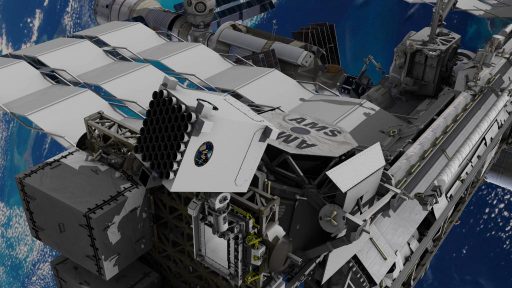
NICER, the Neutron-star Interior Composition ExploreR, with its SEXTANT Extension (Station Explorer for X-ray Timing and Navigation Technology) is an external payload hosted on the International Space Station for the study of neutron stars through soft X-ray timing and a space-based demonstration of pulsar-based navigation that offers much higher accuracy than current radio-based navigation architectures.
Neutron stars are ultra-dense stars that measure only a few tens of Kilometers in diameter but can hold twice the mass of the Sun in an extremely condensed volume at mind-boggling density. They are among the hottest stars and possess the highest stable densities known anywhere. How matter behaves under these extreme conditions has been an open question for decades and a number of theories have been developed over the years, requiring verification via astrophysical observations.
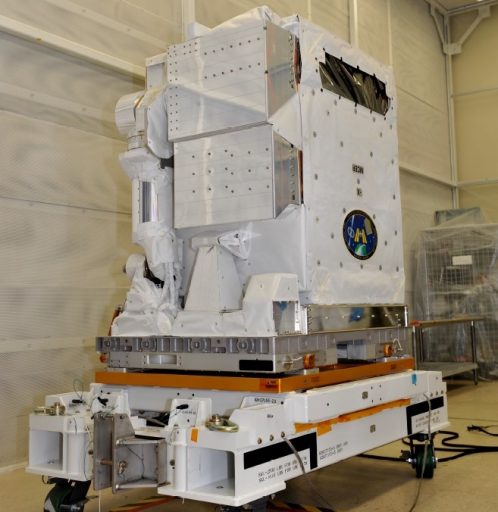
This is where NICER comes in, collecting highly sensitive rotation-resolved spectra of the thermal and non-thermal emissions of neutron stars in the soft X-ray band. This unprecedented measurement accuracy will be used to probe the interior structure, reveal the mechanics of dynamic phenomena and understand the physics of ultra-energetic particle acceleration at neutron stars.
What NICER brings to the table is the ability for simultaneous fast timing and spectroscopy with low backgrounds and high-sensitivity. One of the primary goals of NICER is to provide precise measurements of neutron star sizes.
The SEXTANT enhancement of the mission is dedicated to a demonstration of pulsar-based navigation in the operational space environment. Pulsar Navigation makes use of the ultra-regular X-ray emissions from pulsars for spacecraft navigation which provides great promise for future deep space navigation.
The X-Ray emissions from pulsars are created by the rapid rotation of neutron stars and are of very high stability over extended periods of time, thus pulsars can be considered ‘celestial lighthouses.’ In terms of stability, pulsars can surpass even the most accurate atomic clocks by a factor of 10,000; the signals can have periods of a few milliseconds to a few seconds.
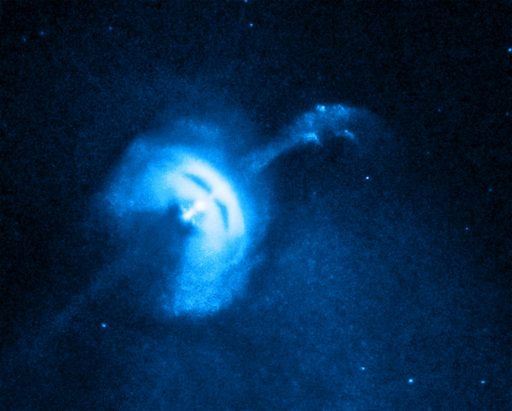
The regular pulse of X-ray photons coming from neutron stars can be used for spacecraft triangulation in deep space, however, the technical aspect of designing a miniaturized device that can detect these pulses has been a challenge in the past.
The realization of operational pulsar navigation would represent a major milestone in deep space navigation. Current missions rely on tracking stations on Earth that measure the craft’s distance to Earth through radio ranging – measuring the light travel time to the spacecraft for a precise determination of its position in space.
NICER/SEXTANT was selected by NASA’s Science Mission Directorate in 2013 as an Explorer Mission of Opportunity – making use of the Space Station as a platform for a low-cost payload that can yield valuable insight into vastly different areas of astrophysics and space engineering. The Space Station’s orbital inclination of 51.6 degrees will provide the instrument with good coverage of the visible X-ray universe to accomplish the one-of-a-kind mission it sets out to realize.
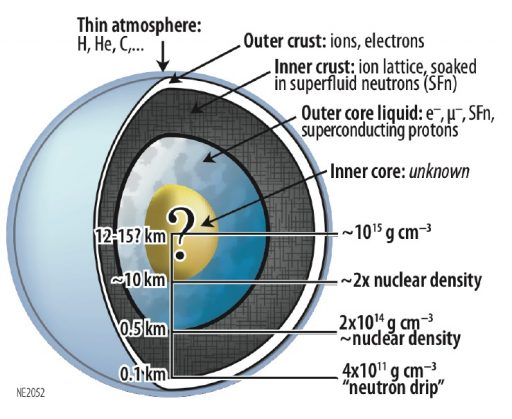
A further extension of the project could facilitate a demonstration of X-ray communications via a Modulated X-Ray Source which – if proven feasible – could enable the exchange of information at gigabytes of data per second over cosmic distances.
The presence of exotic phases of matter in the innermost core of neutron stars has been part of a number of theories and is a key to understanding the physics of ultra-dense matter as well as the astrophysics of late stellar and binary evolution. Per current knowledge, Neutron Stars host a thin atmosphere rich in Hydrogen and Helium, an outer crust of different ions and free electrons, an inner crust composed of an ion lattice in superfluid neutrons and an outer core of electrons, neutrons and superconducting protons. Whatever lies in the center of neutron stars will be at immense pressures of 2x nuclear density.
Different models based on the Equation of State have been worked out connecting a star’s mass to its radius, stipulating that the radius will shrink as the mass grows taking into account gravitational phenomena. The mass-radius relations, however, differ from model to model due to different assumptions made for the interior structure of Neutron Stars. NICER will attempt to isolate models that are consistent with observed stars and rule out many alternatives.
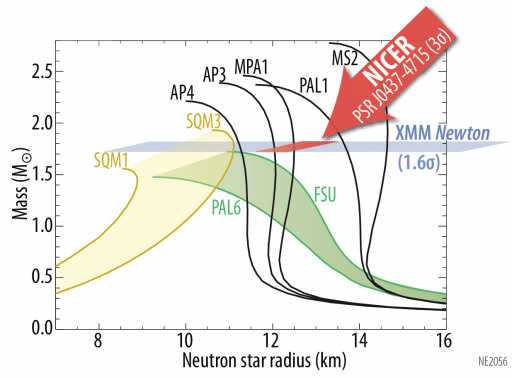
To constrain Neutron Star masses and radii, NICER uses an approach of monitoring X-ray flux modulations due to rotating hot spots on the surface of a neutron star. Lightcurve analysis at a high spectral and temporal resolution will yield an uncertainty of +/-5% on radius measurements. Overall, NICER will improve existing observations by a factor of 12, allowing certain Equation of State families to be ruled out.
Constraining masses will be only possible for binary Neutron Stars through the general-relativistic Shapiro delay.
The passage of light through a significant change in gravitational potential over finite distance causes a time delay. This retardation of a pulsar signal traversing the gravitational well of its binary companion is typically only accessible to radio observations, but NICER’s pulse Time-Of-Arrival measurements will be able to yield masses for certain binary systems.
Additional objectives of NICER include the measurement of Neutron Star rotation rates relevant for lightcurve analysis, definitive measurements of the clock stability of Microsecond Pulsars, constraining cooling histories of Neutron Stars by separating cooling-surface emission, heated polar caps, and nonthermal magnetospheric emission, and determining radiation patterns and spectral phenomena across the soft X-ray bands.
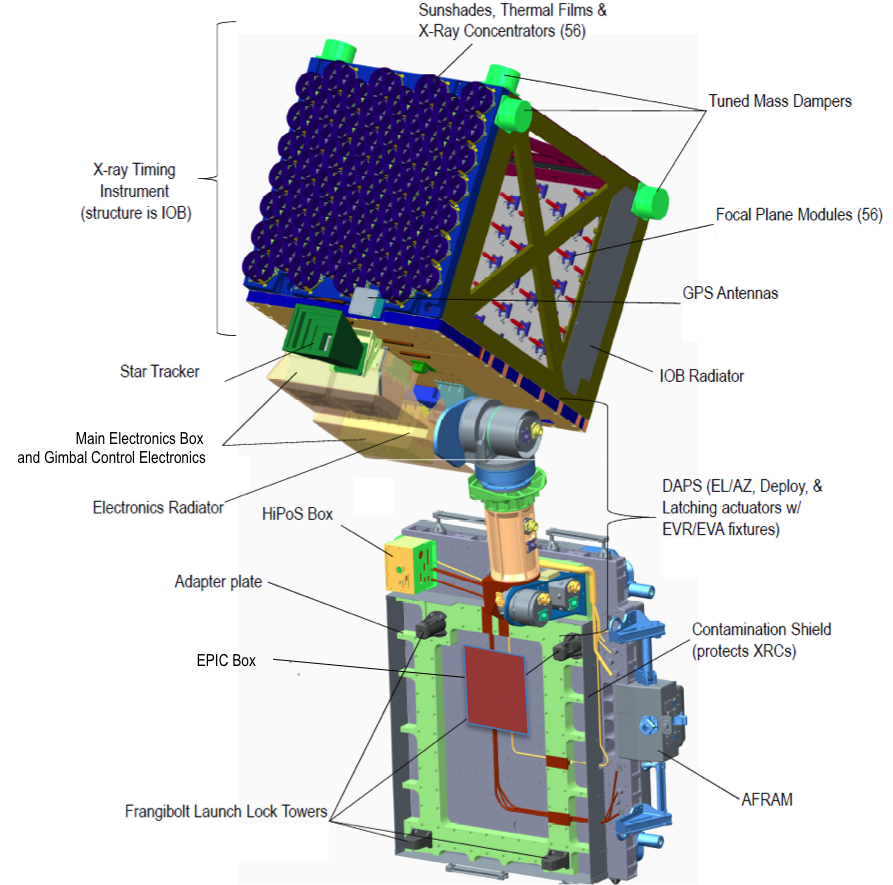
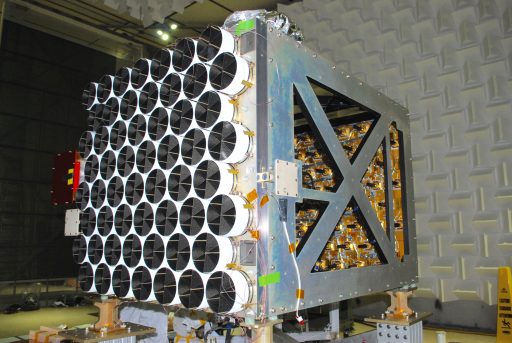
The heart of NICER is XTI – the X-ray Timing Instrument that hosts a total of 56 X-ray telescopes featuring X-ray concentrator optics feeding Silicon Drift Detector pairs.
Each concentrator collects incoming X-ray photons over a geometric area of around 30 arcmin² and focuses them onto the detector which measures the energy of each photon with high spectral resolution and their detection times with an unprecedented 100-nanosecond accuracy – giving NICER its major advantage over heritage sensors. The instrument covers an energy range of 0.2 to 12 kilo-Electronvolts which includes typical neutron star spectra plus a broad collection of other astrophysical sources.
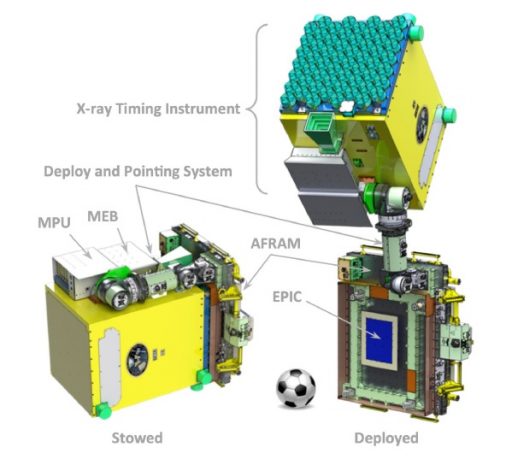
The NICER Payload comprises three major components – the X-Ray Timing Instrument with the concentrators & detectors housed in a rigid assembly, a Deploy and Pointing System (DAPS) with two moving joints to point the instrument to its respective targets, and a Base Module with the Flight Releasable Attachment System, protective shields and electronics.
NICER will take up residence on the space-facing side of Express Logistics Carrier 2 on the starboard truss of the International Space Station, booked for a stay of at least 18 months, with mission extensions depending on payload performance.
The Instrument Optical Bench is responsible for keeping the X-Ray Concentrator and Focal Plane Modules in optical alignment and maintain a focal distance of 1085 millimeters. It is a bolted, box-shaped structure comprising five machined aluminum panels and two honeycomb panels.
The Concentrator Plate holds the 56 X-Ray Concentrators each with thermal filter, sunshade and grazing optics. It also facilitates four frangibolt launch lock actuators that firmly secure the optical bench to the instrument base plate until deployment.
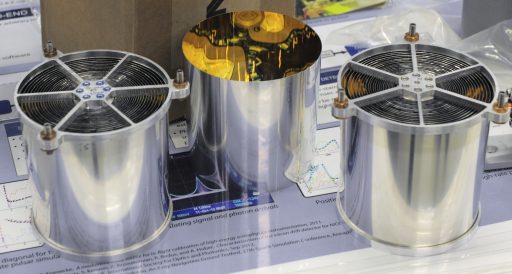
Opposite of the Concentrator Plate is the Detector Plate holding the 56 Focal Plane Assemblies and silver/gold-plated cones, lead disks and collars that act as radiation shields. In essence, NICER hosts 56 parallel telescopes held in alignment by the optical bench that is of necessary stiffness to ensure the optical alignment.
Installed on the outside of the IOB is a an Electronics Deck with Star Tracker, Data Processing Unit and Main Processing Unit; and an Avionics Deck with Main Electronics Box and Gimbal Control Electronics. The Electronics Deck uses four titanium flexures to provide thermal decoupling from the optical bench and hosts the star tracker unit for the acquisition of precise pointing data and feedback for the pointing mechanism. Similar flexures are used by the Avionics Deck where the main instrument control and pointing controller reside.
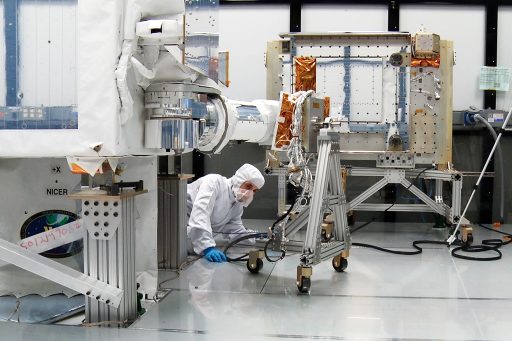
The Pointing System slews the Optical Bench to point at celestial targets and tracks them as the Space Station rotates over the course of every orbit to maintain its nominal local-vertical/local-horizontal attitude. When one target sets, the actuator slews to the next target on command and moves back into tracking mode. During ISS operations like vehicle arrivals, robotics, spacewalks and reboost maneuvers, NICER will be moved back into its stowed configuration to provide contamination protection.
The Pointing System also completes the initial deployment of NICER once installed on ISS. It provides a nearly hemispherical field of regard around the zenith (sky-facing) hemisphere of ISS. Major components of the Pointing System are the Deployment and Pointing System Mechanism Assembly, actuators, gimbal control electronics, the star tracker and tuned mass dampers.
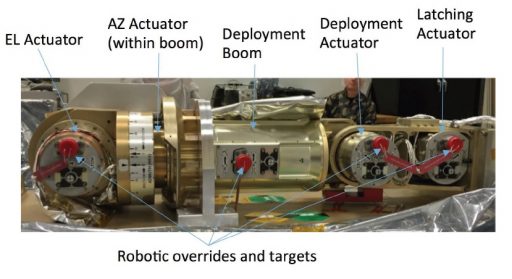
Two actuators provide azimuth and elevation steering, employing Moog-built stepper-motor Rotary Actuators with modifications to reduce detent torque and achieve an accuracy better than +/-0.25°. Hall-effect sensors on the actuator input deliver home position information with an accuracy of two actuator steps. A third actuator near the base plate serves as deployment actuator, in charge of raising and lowering the DAPS boom in order to position the optical bench above most structural viewing obstacles on ISS. Finally, a latching actuator can release and re-lock the deployment actuator to provide stability in either the stowed or deployed configuration.
The Gimbal Control Electronics GCE) receive commands from the NICER flight software or the ground system through the Main Electronics Box. GCE monitors actuator position and stops motion before hitting any hard stops, it also provides joint angle telemetry, sensor status and motor step counts.
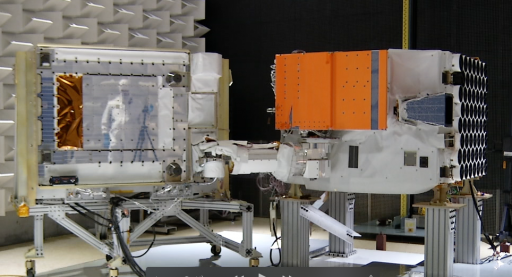
The Star Tracker, provided by DTU Space, Denmark, is aligned with the optical axis of the X-ray instrument and provides precise attitude information to the instrument controller at a refresh rate of five times per second. Furthermore, it includes internal micro-electromechanical gyros and accelerometers to allow the star tracker solution to be propagated to a 10Hz rate and to patch gaps created by solar exclusions or structural blockages.
The Tuned Mass Dampers (TMDs) within the Pointing Mechanism dissipate vibrational energy from the structure – avoiding a transfer of ISS-induced disturbances or low-frequency vibrations from the actuators into the optical bench.
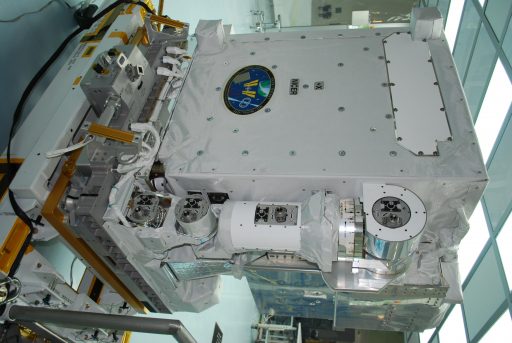
NICER interfaces with ISS via a standard Flight Releasable Attachment Mechanism (FRAM) which also houses electrical and data interfaces. The base plate of the instrument, machined from aluminum, is 50mm thick and facilitates four launch lock mechanisms that hold the optical bench firmly in place in the high-G and high-vibration environment of launch. The locks use a shape memory alloy which, when heated to 80°C, will recover to its original length and intentionally overload a bolt to failure in order to break the launch lock.
NICER can be operated directly from ISS-provided 28-Volt power or from standard 120V power that would be re-conditioned by the ExPCA Power Interface Controller (EPIC) – a dedicated power converter that interfaces with the Main Electronics Box (MEB). 120V power is employed for heaters on the instrument.
ExPCA is the central data and power hub of the Express Logistics Carrier, delivering power and different data feeds to payloads and EPIC hosts three DC/DC converters to deliver up to 500 Watts of power to NICER plus 105W of unswitched 120V power that is delivered to the High Power Switching Box which controls the instrument’s survival heaters.
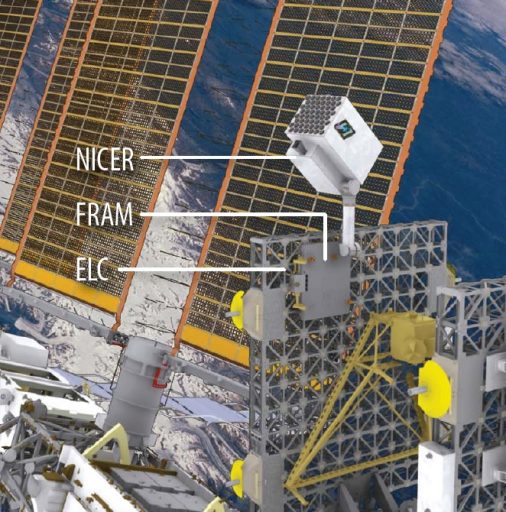
The MEB contains the instrument’s single-board computer running the flight software and processing GPS navigation data. It also handles communications using a MIL-STD-1553 data bus for commanding and housekeeping telemetry downlink, an analog RS-422 bus for internal commanding, science data transmission via Ethernet and a Pulse Per Second signal delivered to various subsystems for time synchronization. MEB contains multiple printed circuit boards, all necessary electrical components, circuits, software/firmware, interface connectors, and structural chassis to command, control, distribute power to and provide telemetry from all other components.
Thermal control for the NICER payload was one of the more complex problems to solve given the instrument’s requirements. The instrument’s electronics generate much heat that needs to be dissipated during operation, but on the other hand, the same electronics need to be able to remain above their survival temperatures during NICER’s transfer from Dragon to ISS, creating up to six hours without heater power. Also, the optical bench must be kept in precise alignment in the extreme thermal changes of the Space Station’s orbit.

Chosen for NICER’s thermal control needs was a combination of radiators, phase change material (PCM), heaters, coatings and multi-layer insulation. The PCM in particular allows the instrument to deal with varying thermal situations. The material can store energy when in a warm environment and release that energy while undergoing the phase change from a liquid to a solid state. The PCM is sealed within mounting decks that are thermally coupled to the various electronics boxes and take on heat during orbital day and release it during orbital night.
For NICER’s installation, the instrument will complete a heat soak while still in Dragon’s trunk and live off the heat from the PCMs until being re-powered after installation.
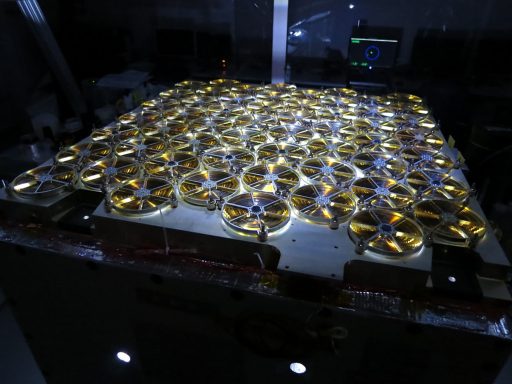
Alignment of the concentrator and detector plates over a long focal distance of one meter is another important requirement for the instrument. Thermo-mechanical disturbances are avoided by means of flight-software-controlled heater circuits in both of the plates in order to maintain positive temperature control in various solar illumination conditions by matching the temperature of the concentrator plate to that of the detector plate.
The key measurement to be collected by NICER – in addition to sensitive spectral data – is the pulse arrival times of X-ray photons at a high signal-to-noise pulse profile and with short integration times. This requires a detector with a large effective area and a sensitivity in the X-ray band where millisecond pulsations occur.
NICER employs an array of 56 identical telescopes comprising the concentrator and detector modules. Each of the concentrators consists of 24 nested foils that from parabolic surfaces making up the grazing incidence optics that concentrate the X-rays onto a small 2-millimeter unobstructed circular aperture detector area.
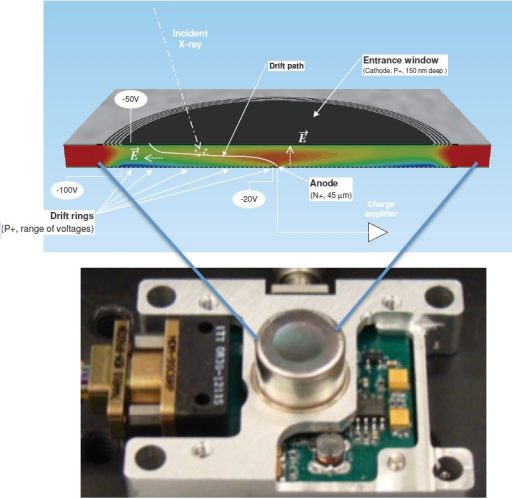
X-rays require grazing incidence optics because the conventional telescopes employing lenses or mirrors are of no use for X-rays – transparent lenses have a refractive index substantially different than one whereas X-rays require refractive indices very close to one, and mirrors, when used at near-normal incident angles, will not reflect the x-rays, instead transmitting or absorbing them which is of no use when trying to focus X-rays onto a detector.
NICER transmits X-rays to the detectors with only one bounce off the optics instead of upwards of two transmissions in traditional Wolter-type telescopes. This is critical in reducing the efficiency penalty caused by the optics.
The detectors employed by NICER are commercial 25 mm² silicon drift detectors that have very high quantum efficiency over the photon energy range of interest. SDDs operate by converting X-ray photons into electrons which generate a voltage pulse on the detector electrodes that can be amplified and digitized. They provide a high time resolution of 100 nanoseconds and a spectral resolution of 120 electronvolts. Rejection of background particles is accomplished very efficiently by their energy deposition as well as filtering of events that occur outside the illuminated detector area.
The dual-channel detector read-out chain has a fast channel with a 30-nanosecond shaping time that enables precise timing of individual photons. Time-shaping to absolute time readings in UTC is accomplished with a highly stable oscillator that is cross-checked with a pulse-per-second signal generated via GPS. A slow shaper operates at 300ns but delivers a better energy resolution which enables NICER’s spectroscopic science objectives.
Each detector is mounted on a thermoelectric cooler which maintains a constant detector temperature of -60°C while the rest of the instrument is at room temperature.
